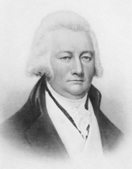|
Buttons of an
Additional Continental Regiment
Over 209 years after it had been lost, it lay in the
palm of my dirty hand. A worn one piece white metal
button, its face caked with orange mud.
It was 1986 and I had been hunting here for a little over 6
months. These quiet woods were the site of a brigade
size encampment occupied by Pennsylvanians under command of
General Anthony Wayne in 1777. Even 200 years later one
could look out from the encampment site and see the city of
New Brunswick seven miles away. It wasn't hard to
imagine soldiers standing here gazing at the smoke from
thousands of British campfires that must have stained the
skyline back in those uncertain days.
Its hard to describe the feeling I got when I
found that particular button. Staring at a piece I knew
had once adorned a soldiers uniform but not yet knowing if
this button was going to be a plain flat button, decorated
civilian button or a marked American Regimental button.
I vaguely remember making a deal with God and feeling like I
was tottering on a razor's edge between victory or defeat.
It may be silly but I just kind of sat there, staring at this
lump of mud, knowing that a quick wipe would probably reveal a
plain face but holding out a faint hope that this might be
something special like a USA button.
|

|
Little
did I know at that moment, that I had made a
Revolutionary War relic hunters "find of a
lifetime" and that 30 feet away from where I was
standing, I would find an identical button one year
later.Carefully brushing off the mud, I could see
right away that this was no plain flat button.
My heart was beating like a drum as the letters
"HR" stared back at me. I had never
seen another button like this one. I knew this
one was good.........real good. |
By the end of the day, I was able to piece together
the rest of this story and determine the
significance of the "HR" button and how it
had gotten to where I found it.
The spring of 1777 marked a new, more positive
period in American military history. The
stunning and unexpected victories of Washington's
army at Trenton (December 26, 1776) and Princeton
(January 3, 1777) in New Jersey all but erased the
effects of disastrous losses the
previous fall. The British army which had
controlled most of Central New Jersey at the end of
1776 now found itself pinned in fortified garrisons
along a 10 mile stretch of the Raritan River from
Perth Amboy to New Brunswick. An American army
that was at the point of simply dissolving at the
beginning of December 1776 now found itself
victorious and strengthened by the daily arrival of
new recruits from all over the rebellious colonies.
Near Morristown, N.J. the main Continental Army
was hutted along the wooded slopes of the Watchung
Mountains. As the spring campaign season
approached, brigade by brigade, the Continentals
moved southward toward the Raritan Valley and New
Brunswick. Advanced American outposts at
Quibbletown, Bound Brook and Somerset Court House
had detected activity in the British lines that
indicated a possible advance by the enemy from New
Brunswick towardsPhiladelphia.
|
|
NEXT PAGE
|
|